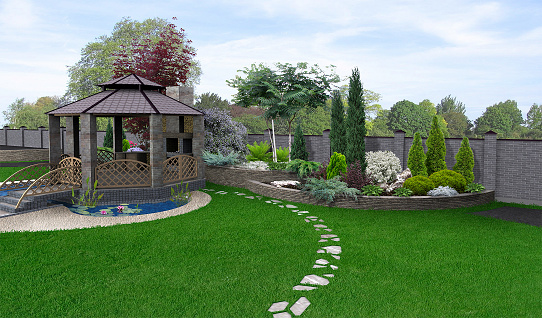How to Build a Garden Retaining Wall

If you’re planning to build a garden retaining wall, there are several different ways to go about it. There are many options. These include sheet piles, railroad ties, interlocking blocks, Gabion walls, and sheet piles. While the most obvious option is to hire a landscape architect to create your garden retaining wall for you, you may prefer to do it yourself.
Gabion walls
Gabion walls are a very functional and cost-effective method of creating a retaining wall for the garden. They can also be used to divide areas or surround outdoor fire places.
Gabion walls can also be made from concrete or stones. Angulous rocks are the best material.
Another material that is often used for gabion walls is broken concrete. They are inexpensive, easy to find, and very cheap to install. The quality of the material used is important.
Depending on the size of the project, you may need heavy equipment to help complete the task. You will also need to consider the type of foundation that you intend to use. This can add to the overall retaining walls adelaide cost of your project.
You can also build a gabion wall yourself. The process is straightforward, but it does require a bit of physical labor. You should be able complete the job if you have a plan.
Gabion walls are great for stabilizing soil around your garden and preventing erosion. You can also use them to seperate a green area from a dry, dusty one.
Keep in mind that the materials you choose must be strong and not porous. Otherwise, they can freeze and crack in the winter.
Also, ensure that the gabion baskets have been filled. This can be difficult if you have a small project.
There are many other options available, but gabion walls are a great way to create a sturdy, cost-effective retaining wall. They also have an industrial, modern look.
You want to get the best out of your gabion walls. Make sure you choose the right material for filling. You have many options. It is also a great medium for blinding, so it is worth considering a well-graded granular product.
Finally, make sure you consult a structural engineer before you decide on a design. You will need to consider several factors such as the shape of the mesh, the density of filling materials, and how resistant the mesh is to corrosion.
Read More: Types of Investment Accounts
Sheet piles
Sheet piles are used for garden retaining walls to provide lateral support to the soil around the structure. This can be a cost effective method of supporting structures and can be installed in a short period of time.
There are two main types of sheet piles. They include pan-type and U-type sheet piles. The former is a thin sheet commonly used for drainage, while the latter resembles a horizontally stretched-out Z. Both of these piles can be found in a variety of configurations.
When choosing a type of piling for your retaining wall, you must consider the materials that will be installed and the method of driving the piles. You may choose to use timber, steel or vinyl sheets for the piling material.
One of the main reasons for installing a sheet pile wall is to prevent the soil from moving near a foundation. It can also be used to shoring excavation work.
The strength and stiffness of the sheet pile retaining wall depends on the type of material and the design. Steel is usually recommended for heavy bending forces. Higher strength steels are available to provide extended bending strengths and weight savings. A combination of steel and anchors can be used to provide further lateral support.
To determine the thickness of the sheet piling wall retaining wall, it is necessary to know how much load it can withstand. This can be calculated by dividing its load by the amount of water it will hold.
For a straight wall, you will need a temporary driving guide to keep the sheet piles plumb. This guide will also help to establish accurate wall position.
A contractor can help you determine the best way to install a sheet pile wall in your construction project. Depending on the application, they can be hammered into the ground or driven by vibratory hammers. Some can be installed using a vibration-free installation device.
Using the right type of sheet piles for your retaining wall can have many benefits. In addition to providing long-term structural support, they can be recycled, and they are environmentally friendly.
Blocks that interlock
If you’re looking to build a retaining wall, you should consider using interlocking blocks. They’re easy to install, come in a variety of sizes and colors, and can be customized to suit your needs. Plus, they’re a green alternative to traditional mortared masonry.
In addition to being strong and durable, you can choose from a number of finishes to make your walls look beautiful. You can have blocks with a veneer or a penetrating finish.
For example, the flagstone block has a natural flagstone look and is available in several colors and shades. This type of block is easy to use to make curved walls.
Another option is the cinder block. Cinder blocks have the appearance of weathered natural stones. Using this style of block, you can create a retaining wall with steps.
If you’re building a retaining wall on a slope, you’ll need to bury the pipe ends in the back of the wall. This will keep the pipe from spilling out of the wall and causing damage.
Then, you’ll need to dig a trench. It’s important to ensure it is wide enough to hold the blocks, and deep enough to support the gravel that you will use as a subbase.
Once you’ve dug the trench, it’s time to put the blocks in. Each of the interlocking blocks has a male stud and a female recess, so they’ll lock together easily. These stones can be ordered with thin “toppers”, which will create an interlocking joint.
You will need more or fewer blocks depending on the height of your wall. You should place one block per linear ft. Or a minimum of one per linear ft.
To secure the block walls, use Loctite PL Landscape Block Adhesive. It is an exterior heavy duty adhesive that can be used with any type landscaping project. Look out for new level landscapes.
It can be difficult to build a retaining wall. You might consider hiring a professional if you aren’t used to digging in dirt. Most homeowners can do it themselves.
Railroad ties
Railroad ties are a versatile material that can be used for a variety of projects. They are strong, durable, and affordable. They can be used to build a retaining or raised garden bed, as well as steps. These are an excellent option when you need a long lasting, stable barrier in your garden.
If you are planning to use railroad ties to build a retaining wall, you should start by leveling the ground. This will ensure that the walls are straight and level. This can be done with a shovel or a level.
Next, you should dig a trench 12 inches deep and at least 16 inches wide. You should then lay down 3/4-inch gravel in the trench. Once the gravel is in place, smooth it out with a rake.
The bottom ties should be buried partway. Secure them with rebar. Then, drive the rebar down until it is flush with the top edge of the tie.
Once you have all your railroad ties, fill in the gaps between them and ground. This will improve drainage. To prevent the wall shifting, you will need to tamp down the dirt.
After you have filled the tie wall in, you should secure the ties with rebar and nails. You can also use adhesive construction.
A railroad tie retaining wall is a great option if you want to create a long lasting, sturdy barrier in your garden. The process is very simple. All you need to do is get the right tools and know how. Railroad ties are a great way of saving money and helping the environment.
You can add a decorative border to complete your project. You can also use sod to cover railroad ties. You can also use plants to blend the retaining walls into the landscape.
A railroad tie retaining walls can be completed in less than a week. It is an effective way to stabilize your garden and improve drainage.





